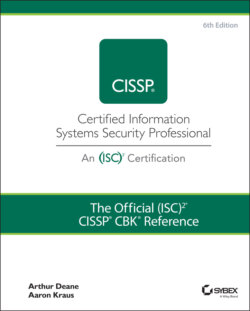Читать книгу The Official (ISC)2 CISSP CBK Reference - Leslie Fife, Aaron Kraus - Страница 46
Legislative and Regulatory Requirements
ОглавлениеMany compliance expectations come from statutory or regulatory requirements that apply broadly to all industries. Others are specific to certain industries or products. This ever-changing set of expectations requires a continuous review of organizational practices to ensure that information is protected in compliance with all applicable requirements.
NOTE Because there are many compliance requirements that relate to information security, many people often confuse the two or assume that being compliant is the same as being secure. As a CISSP, you should understand that compliance requirements generally serve as a solid baseline for security, but being compliant with security regulations and standards is only the first step toward being secure.
The first challenge in identifying compliance requirements involves knowing which jurisdiction has the legal authority to set those requirements. Jurisdiction is a legal concept that establishes the official power to make legal decisions and judgments. It is not enough to know the relevant geography or political boundaries; jurisdiction may also be influenced by international treaties and agreements, the activity of your organization, or any number of other factors. Regardless of the example laws and regulations listed in this text, information security practitioners must be aware of the nuances of the jurisdictions in which they operate.
In most jurisdictions, laws are established to define what is permissible and what is not. In U.S. law, the word law refers to any rule that, if broken, subjects a party to criminal punishment or civil liability. Laws may be generally categorized into two parts: statutes and regulations. Statutes are written and adopted by the jurisdiction's legislative body (e.g., U.S. Congress), while regulations are more detailed rules on how the execution of a statute will be performed. Both statutes and regulations are legally enforceable, but regulations are subordinate to statutes.
TIP While you don't need a law degree to be an information security professional, it certainly helps to Article 17 have a basic understanding of legal jargon. Since you must learn to read laws and understand how they apply to information security, it's important that you can interpret how laws are usually cited, particularly in the United States. If you see 18 U.S.C. § 1030, for example, you should understand that this refers to Section 1030 of Title 18 of the United States Code. You may see C.F.R. used to reference the Code of Federal Regulations. In the United Kingdom, laws are cited in the following manner: Title of Act Year, Chapter Number (where the chapter is optional); “Computer Misuse Act 1990, c. 18” is an example.
There is a growing number of legislative and regulatory requirements in the United States and around the world, but there are two overarching U.S. laws that you should be familiar with:
U.S. Computer Security Act of 1987
U.S. Federal Information Security Management Act (FISMA) of 2002
